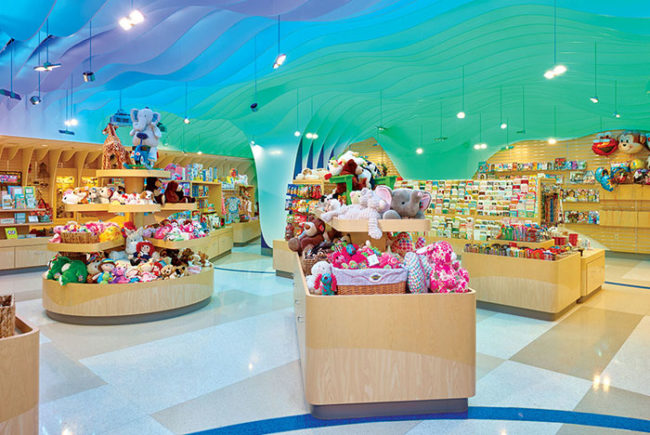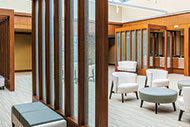 |
|
PHOTO COURTESY OF SMITH SECKMAN REID INC. This cardiovascular facility contains both Group I-2 and Group B occupancies. |
HVAC design is more than performing heating and cooling load calculations, selecting a system type and equipment, and connecting the dots. System designers also need to know the type of space the system serves, the occupancy type and codes that govern the occupancy.
Good engineering practices and published data offer more questions than answers until the building requirements are broken down into what is relevant for proper design, ventilation rates and temperature control aspects.
HVAC design goals
The goal of HVAC design has remained constant over the years: to efficiently provide safe, comfortable environments. However, the process continues to be refined and challenged by the codes in effect, required energy efficiency of both equipment and system operation and, most importantly, by occupant comfort, ventilation and air quality.
You may also like |
| HVAC equipment for health care |
| Hospital airflow regs and trends |
| HVAC system selection |
| |
HVAC designs, parameters, guidelines and governing codes have continued to evolve and develop with additional standards over the past several years. One of the challenges to engineers and designers is not that there are codes, but under which edition of which code will the design be based and reviewed.
Most model codes, such as the International Code Council’s International Building Code (IBC), International Mechanical Code and International Plumbing Code, have three-year update cycles as well as some National Fire Protection Association (NFPA) codes like NFPA 70, National Electrical Code (NEC); NFPA 101, Life Safety Code (LSC); and NFPA 99, Health Care Facilities Code.
Other standards such as NFPA 90A, Standard for the Installation of Air-Conditioning and Ventilating Systems, and NFPA 96, Standard for Ventilation Control and Fire Protection of Commercial Cooking Operations, have had more random change periods but are moving toward three-year cycles as well. Throw in the authorities having jurisdiction (AHJs) with their code adoption time frames and their amendments, and a design project in 2015 might be using the 2006 IBC, the 2003 LSC and the 2014 NEC.
A different way of thinking and organizing are necessary when designing a Group I-2 health care occupancy over the business Group B occupancy.
Group I-2 occupancies. General hospitals, special or specialty hospitals, surgery centers and other outpatient diagnostic and treatment facilities fall under the IBC’s I-2 occupancy classification. The 2006 IBC identifies I-2 occupancy as buildings and structures used for medical, surgical, psychiatric, nursing or custodial care on a 24-hour basis for more than five persons who are not capable of self-preservation. Both the 2009 and 2012 editions read similarly and reflect the criteria for more than five persons.
In contrast, the 2003, 2009 and 2012 editions of the LSC identify a hospital and health care occupancy as a building or portion thereof used to provide medical care and treatment on either a 24-hour basis to four or more patients, or medical care or treatment simultaneously to four or more patients on an inpatient basis. An ambulatory health care occupancy provides services or treatment simultaneously to four or more patients, on an outpatient basis, treatment, anesthesia, emergency or urgent care that renders the patient incapable of self-preservation or incapable of taking action for self-preservation under emergency conditions without the assistance of others.
The difference is the minimum number of persons or patients treated. As codes state, where there is a discrepancy or conflict, the more stringent shall apply. Thus, the number of patients that will be treated needs to be identified in addition to the occupancy classification because the more stringent definition will trigger the reference to other documents. This includes documents such as the Facility Guidelines Institute’s (FGI’s) Guidelines for Design and Construction of Hospitals and Outpatient Facilities (2010 or 2014 edition), which incorporates the 2008 or 2013 edition of the American National Standards Institute (ANSI)/American Society of Heating, Refrigerating and Air-Conditioning Engineers (ASHRAE)/American Society for Healthcare Engineering’s Standard 170, Ventilation of Health Care Facilities, if adopted by the AHJ or other state or local jurisdictions that review or license the project.
Additionally, I-2 occupancies require a higher level of life safety consideration because the patients receiving treatment generally are not capable of self-preservation. This, in turn, places the more stringent requirements on the HVAC system design. The need for smoke compartmentation, horizontal exits, fire-rated walls and barriers or other areas of refuge add complexity to HVAC duct design and to the owner’s maintenance and operation if a plan to avoid these dampers is not laid out. Control of HVAC systems, including the smoke dampers, equipment operation and emergency power requirements, are also different from B occupancies.
One of the keys to planning and selecting the HVAC system is to determine the codes to which the project must be designed, and to work from an architectural floor plan that has the appropriate space names identified. At this point, the project medical planner is an integral part of the HVAC design process. While some projects may include shell spaces, it is important for the HVAC designer to know the anticipated future use. For example, in an imaging suite with shelled areas, it is important to determine if the space will be for magnetic resonance imaging or computed tomography (CT) with an equipment room or perhaps patient holding or ultrasound rooms. Each of these has different heating and cooling loads and air-change requirements.
Health care occupancies by room type have specific minimum air change per hour (ACH) requirements for both total and outside air as noted in the ventilation rate table in ASHRAE 170 or similar local hospital design and licensing regulations. The ventilation rates noted in the table are intended to provide for comfort, as well as asepsis and odor control in areas of patient care and treatment. For many areas not noted in those tables, the space type usually can be found in ANSI/ASHRAE 62.1-2010, Ventilation for Acceptable Indoor Air Quality.
It is also worth noting that filter minimum efficiency reporting value ratings, air flow supply and removal locations and direction, pressure relationships and sound transmission or noise criteria are identified for specific room types as health care design parameters and included as part of the HVAC design criteria. Health care-specific codes also note areas of patient care that require fully ducted supply, return and exhaust air systems (e.g., critical areas, sensitive areas, food preparation and general patient care), while fully ducted systems may be desirable in business occupancies, but not specifically required. To maintain clean environments and required pressure relationships, fully ducted systems are needed. A building may have multiple occupancies as long as proper rated separations are appropriately placed.
The I-2 occupancy also may require additional room types such as airborne infectious isolation rooms, a disturbed-patient room and bariatric patient rooms if patient sleeping rooms are provided as part of the program design and layout. The building owner or user has significant input into the project design and practices for the institution; he or she will establish and convey any risk assessment associated with patient care and treatment through the facility’s infection control and safety staff to the design team.
Fully ducted systems also may be planned for future flexibility in expanding or changing space occupancy types. HVAC design also depends on available space within the building and above the ceiling. Sometimes buildings that house business occupancies have shorter floor-to-floor heights to take advantage of the less-stringent system requirements and the fewer mechanical-electrical-plumbing systems that are placed above the ceiling.
Group B occupancies. Outpatient clinics, physician and dental offices, ambulatory outpatient clinics and related professional service offices are classified as business Group B occupancies by the building code. However, a facility or building that officially is identified as an Ambulatory Health Care Occupancy is classified as an I-2 occupancy.
The 2006 IBC identifies a Group B occupancy as “the use of a building or structure, or portion thereof, for office, professional or service-type transactions, including storage of records and accounts.” Both the 2009 and 2012 IBC editions read similarly to that in the 2006 edition. The 2003 LSC identifies a business occupancy as “an occupancy used for account and record-keeping or the transaction of business other than mercantile.” The 2009 and 2012 editions read similarly to the 2003 edition wording.
The importance of the occupancy determination then identifies which additional codes must be used for the HVAC design criteria. As health care-specific codes normally would not be applied to a business occupancy, model code occupancy requirements and referenced standards such as ASHRAE Standard 62.1; ANSI/ASHRAE 90.1, Energy Standard for Buildings Except Low-Rise Residential Buildings; and NFPA Standard 90A would need to be considered as part of the HVAC design criteria.
Sometimes a physician office and clinic have equipment and staff that perform procedures similar to those in hospitals and outpatient occupancies. These could include endoscopic procedures, CT scans or cancer treatment functions.
As long as the number of simultaneously treated patients is fewer than health care occupancy definitions, no additional code-related requirements are needed in the design. However, some consideration might be given to space temperature, airflow direction, pressure relationships and filtration to enhance the comfort and care of the patient and health care providers.
Prior to any design, it is important to understand the space use, the procedures to be performed and the number of patients who will receive treatment at any given time. This information helps to determine the HVAC design parameters for the project. It also provides a good platform from which to discuss the project with owners, architects and the AHJ so that agreement on the design approach and anticipated results can be reached.
Careful planning
Designing an HVAC system for any building type requires careful planning. In health care, however, it also requires more information to meet the increased design complexity of these facilities.
J. Patrick Banse, PE, LEED AP, is senior mechanical engineer and technical resource for the mechanical and plumbing disciplines at Smith Seckman Reid Inc., Houston. He can be reached at pbanse@ssr-inc.com.
Some airflow considerations for specific health care areas
Patients being treated in a hospital or outpatient setting are particularly susceptible to drafts, sudden temperature changes or uncontrollable conditions along with possible exposure to health care-associated infections. They usually do not have the ability to get a blanket or other clothing for warmth due to the nature of their illness or medical treatment. Local adjustment and individual room control are essential to ensure the level of comfort required in the many types of treatment areas immediately available to them.
The ventilation criteria noted in American National Standards Institute/American Society of Heating, Refrigerating and Air-Conditioning Engineers/American Society for Healthcare Engineering’s Standard 170, Ventilation of Health Care Facilities, tables also include temperature and relative humidity design parameters for the various treatment areas and show required ranges for such spaces as operating rooms, nursing unit patient rooms and treatment rooms.
The variable temperatures are minimum ranges due to the procedure being performed, staff comfort or patient comfort. System performance outside of these ranges may be desired depending upon local conditions and practices.
The health care occupancy codes also require continuous ventilation of patient care and treatment areas by having the air supply and removal systems connected to a source of emergency power. Heating systems in climates where the winter design temperature is below 25 F are required to provide a source of heating when one of the heat sources or accessories is out of service.
Some staff work areas such as labs and central sterile processing might require lower ranges because of the extra layers of clothing worn for personnel protection. Other areas like pharmacy IV prep rooms, may need lower space temperatures and high air change rates with specific airflow direction and filtration. This sterile preparation area has additional code requirements beyond the health care listed minimums and are governed by the requirements of the U.S. Pharmacopeial Convention’s USP 797.
The Facility Guidelines Institute’s Guidelines for Design and Construction of Hospitals and Outpatient Facilities, which incorporates Standard 170, indicates supply air diffuser types and locations, filtration and air removal locations to meet effective design airflow and temperature criteria. Air device locations and exit air velocity and throw are critical considerations in maintaining patient comfort by avoiding drafts and allowing individual control of space temperature.





